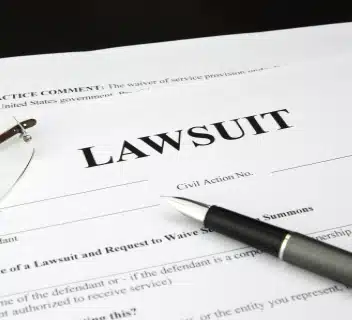Understanding California SOL on Personal Injury Discovery
In California, understanding when the statute of limitations (SOL) starts for personal injury cases is critical. Typically, you have two years from the injury date to file a lawsuit. However, the California discovery rule can extend this period. It starts the clock when you discover the injury or should have reasonably discovered it, not necessarily when the accident occurred. This article explains the specifics of the California SOL on personal injury discovery and what it means for your case.
Key Takeaways
- In California, the statute of limitations for most personal injury claims is two years from the date of injury, but the discovery rule allows this period to start when the injury is discovered or should have been discovered.
- The discovery rule is particularly important in personal injury cases where injuries are not immediately apparent, such as in medical malpractice and cases involving latent injuries.
- Tolling factors, such as mental incompetence, legal insanity, and imprisonment, can pause the statute of limitations, allowing claimants additional time to file their lawsuits.
- Invoking the delayed discovery rule is crucial in personal injury claims when injuries are not immediately apparent or the claimant is unaware of their valid claim. This rule can pause the statute of limitations if specific conditions are met, providing claimants more time to seek justice.
Understanding California SOL on Personal Injury Discovery
The statute of limitations defines the maximum time period for initiating a lawsuit after an incident occurs. In the context of California, this duration is specified in sections 312-366 of the California Code of Civil Procedure and serves to facilitate a smoother judicial process by eliminating the risk of perpetual legal disputes. For most personal injury cases in California, individuals have two years from the date on which they sustained their injuries to take legal action.
Yet, with regard to timing, there’s flexibility provided by what’s known as the discovery rule. This rule allows for the commencement of the limitation period from when one actually finds out about their injury or should reasonably have identified it rather than strictly from when an incident takes place. The discovery rule applies in situations where a victim is unaware of their injuries, and a reasonable person in similar circumstances would also not have been aware, thereby extending the time allowed for filing a claim. The significance here lies especially with instances where personal injuries are not obvious at first glance—take hidden internal injuries that only become evident later—as without this exception people might lose their chance at recompense simply due to ignorance about having been harmed.
Understanding both how these statutes operate and how they apply via mechanisms like the discovery rule is critical if you intend to lodge a legitimate claim regarding personal injury within Californian jurisdiction. By doing so, those who sustain delayed-discovered harm maintain access to justice beyond what would otherwise be construed as rigid two-year constraints. Thereby properly aligning individual rights against concerns around efficient resolution processes for disputes.
Introduction
Navigating through the complexities of legal time constraints is an essential part of pursuing personal injury cases within the legal system. The statute of limitations stands as a fundamental rule, establishing the maximum period during which one can initiate legal proceedings after an incident. This critical deadline commences at either the moment when the injury occurs or when it should have been reasonably identified, underscoring its importance in holding liable parties accountable.
In certain scenarios like medical malpractice and various other personal injury instances where injuries may not be readily obvious, applying what’s known as “the discovery rule” becomes indispensable. It allows for recognition that some damages might only become evident over time. Thus, under this provision, the countdown for filing a claim begins upon discovering said harm or when it ought to have been detected—providing vital leeway necessary for fair recourse in such situations where full ramifications are belatedly understood.
Definition and Purpose of the Statute of Limitations
The statute of limitations is a legal time limit within which a person must file a lawsuit or take legal action in a civil case. In California, this legal time limit serves as a deadline for individuals to seek compensation for personal injuries or damages caused by another party’s negligence or wrongdoing. The primary purpose of the statute of limitations is to ensure that claims are brought in a timely manner, while evidence is still fresh and witnesses’ memories are reliable. This promotes fairness, judicial efficiency, and finality in the legal process. By adhering to these time constraints, the legal system aims to prevent the indefinite threat of lawsuits and encourages the prompt resolution of disputes.
Overview of California’s Statute of Limitations for Personal Injury Claims
In California, the time limits for initiating legal claims, including those for personal injury, are outlined in sections 312-366 of the California Code of Civil Procedure. Typically, there is a two-year period from when an injury occurs to file a personal injury claim against the responsible party. The specific duration allowed can differ based on the kind of legal claim you’re pursuing.
Statutes of limitations serve to guarantee that lawsuits are filed within an appropriate amount of time after wrongdoing has occurred. This ensures evidence remains untainted and witness accounts remain reliable. Failing to meet this deadline means forfeiting your right to seek compensation through court proceedings. It’s imperative to take swift action if injured. Seeking guidance from a lawyer specializing in personal injuries early on will clarify any unique deadlines pertaining to your situation and help prevent missing these critical dates.
In wrongful death cases, the statute of limitations in California typically allows family members two years from the date of death to file a lawsuit. However, the emotional challenges faced by survivors can complicate this process. The delayed discovery rule may apply, permitting the statute of limitations to start from the date when the cause of death is discovered, rather than the actual date of death. This can provide additional time for families to seek justice.
The discovery rule can sometimes provide an extension beyond typical statutes’ timeframe where victims may not be immediately aware they’ve been harmed—as often seen with medical malpractice or latent accident-related injuries—thus allowing extra time for submitting their legal claim.
Enlisting a skilled attorney specialized in such matters could prove invaluable by simplifying complex aspects around statutes and ensuring one’s rights remain safeguarded throughout the process.
Types of Personal Injury Claims
Personal injury claims can arise from various types of accidents or incidents, each with its own specific statute of limitations. Understanding the type of claim and its corresponding legal time limit is crucial for individuals seeking compensation. Common types of personal injury claims include medical malpractice, product liability, and wrongful death. Each category has unique considerations and deadlines that must be met to ensure a valid personal injury claim.
Medical Malpractice Claims
Medical malpractice claims involve allegations of negligence or wrongdoing by healthcare professionals, resulting in harm or injury to patients. In California, the statute of limitations for medical malpractice claims is three years from the date of the injury or one year from the date of discovery, whichever occurs first. The discovery rule is particularly relevant in these cases, as it allows the statute of limitations to begin when the injury or its cause is discovered, rather than when the medical error occurred. This is crucial in situations where the harm is not immediately apparent, such as complications arising from a surgical procedure that only become evident months or even years later.
Wrongful Death Claims
Wrongful death claims involve allegations of negligence or wrongdoing that result in the death of an individual. In California, the statute of limitations for wrongful death claims is two years from the date of death. Similar to other personal injury claims, the discovery rule may apply in cases where the cause of death was not immediately apparent. This means that the statute of limitations could begin when the cause of death is discovered or should have been discovered through reasonable diligence. Understanding these nuances is essential for ensuring that legal claims are filed within the appropriate timeframe.
It is important to note that the statute of limitations for personal injury claims in California can be complex and nuanced, with various exceptions and tolling provisions. Consulting with an experienced personal injury attorney can help individuals understand their rights and options for seeking compensation. An attorney with a proven track record in handling personal injury cases can provide valuable guidance and ensure that all legal deadlines are met, thereby preserving the right to seek justice and compensation.
The Discovery Rule in California Personal Injury Cases

The discovery rule is an established legal doctrine allowing for the commencement of the statute of limitations clock at the moment a person either becomes aware or should have become reasonably aware of their injury. This principle is particularly vital in personal injury cases, including those involving internal injuries or medical malpractice, where harm may not be immediately apparent. In California, this discovery rule serves to safeguard individuals’ rights by providing them with a window to pursue legal action even if they uncover their injuries following the lapse of the standard limitation period.
Take, for example, someone involved in a car accident who doesn’t recognize the full extent of their sustained trauma until much later—potentially jeopardizing their chance to file within California’s accepted two-year timeframe. The application of this discovery rule could permit claimants to proceed with litigation after that initial time limit has expired as long as it can be demonstrated that knowledge about such injury was neither known nor ascertainable beforehand. Such flexibility offers equity within judicial processes and accounts for scenarios where late-emerging damages occur.
In these circumstances, professionals operating within our legal system carry significant responsibility when evaluating each case’s details concerning the potential invocation of this doctrine. Leveraging it enables injured parties to deftly manage through complex legal landscapes and upholds justice by recognizing instances where delayed awareness impacts one’s capacity to seek redress promptly because simply discovering certain types of damage takes more than mere observation—it often requires expert assessment beyond what might first present itself post-incident. This is where the need to invoke the delayed discovery rule becomes crucial, as it allows claimants to pause the statute of limitations when injuries are not immediately apparent or when they are unaware of their valid claim.
When Does the Statute of Limitations Begin?
In the state of California, individuals have two years from the date they sustain an injury to initiate personal injury claims. In situations where injuries are not recognized immediately, the statute of limitations is adjusted to start on the date when one discovers or reasonably should have discovered their injury. This adjustment is a result of applying what’s known as the discovery rule and enables claimants to pursue legal action even if their injuries were not evident right away.
When attempting to employ this delayed discovery rule within personal injury cases such as medical malpractice incidents or accidents that may obscure symptoms initially, plaintiffs need to demonstrate that there was no prior knowledge of harm and it could not be identified despite diligent efforts. The rule considers whether a reasonable person in similar circumstances would have been unaware of the injury, thereby extending the time allowed for filing a claim. In instances involving wrongful death matters specifically, rather than starting at death’s occurrence time-wise for statute purposes, its clock begins ticking upon uncovering the cause behind said demise.
Acquiring professional advice from a lawyer adept in handling different types of personal injury scenarios can prove crucial for interpreting applicable statutes accurately according to your case specifics—personalized guidance aids in determining precisely how commencement timing functions with regards to limiting periods (statute), positioning you favorably towards preserving legal entitlements effectively.
Tolling Factors That May Affect Your Personal Injury Claim
Tolling factors can pause the statute of limitations for personal injury claims, allowing claimants more time to file lawsuits. If a defendant is found to be mentally incompetent during the injury, the statute of limitations may be paused. This pause continues until the defendant regains competence. If a victim is legally insane at the time of injury, the statute of limitations is tolled until they regain sanity.
A plaintiff’s imprisonment can toll the statute of limitations until release or for two years, whichever is sooner. Additionally, the statute of limitations might be suspended for the period when the defendant is absent from California after the injury occurs.
Fraudulent concealment by the defendant can toll the statute of limitations until the information is discovered. These factors ensure the injured party can file claims even if certain conditions temporarily prevent them.
Impact of Delayed Discovery on Medical Malpractice Claims
In California, when it comes to medical malpractice, individuals have a maximum of one year from the point they recognize an injury or up to three years following the actual date of injury to initiate legal action – whichever occurs first. This legislation takes into account that injuries resulting from medical negligence might not be immediately apparent and provides patients with time to identify and respond legally to their harm.
The delayed discovery rule permits people to pursue a lawsuit even if the standard statute of limitations period has already expired because they were initially unaware that they had sustained an injury. For example, after undergoing surgery, patients may only become aware of mistakes much later. Under the discovery rule, these individuals still have an opportunity for legal redress beyond the initial one-year limit. To successfully pause the statute of limitations, claimants must invoke the delayed discovery by demonstrating that they were unaware of their valid claim due to the nature of the injury or negligence.
Such provisions are essential within medical malpractice litigations since they ensure that victims retain their right to seek reparation even when there’s a delay in detecting their injuries.
Special Considerations for Minors and Mentally Incapacitated Individuals
In California, the limitations for personal injury claims are prolonged when those injured are minors. These individuals have the opportunity to file a claim once they reach 18 years of age, ensuring that their inability to legally pursue a case before adulthood doesn’t prevent them from seeking legal redress.
Similarly, for those who were mentally incapacitated at the time of sustaining personal injuries, there is an extension on the statute of limitations. This modification underscores California’s commitment to safeguarding vulnerable populations such as minors and mentally incapacitated persons. The discovery rule applies here, where the statute of limitations is extended if a reasonable person in similar circumstances would not have been aware of their injuries. It guarantees that all victims have an equitable chance to proceed with their personal injury claims regardless of mental capacity or age during the incident.
Importance of Seeking Medical Attention Immediately
It is essential to seek medical help as soon as an injury takes place for various critical reasons. Getting prompt treatment can not only mitigate the worsening of injuries that might initially be without symptoms but also decrease future healthcare expenses by preventing the need for more serious interventions. Addressing potential emotional and psychological trauma swiftly after a mishap could prove beneficial.
Maintaining documented evidence through medical records plays a pivotal role in linking your injury directly to the incident, which greatly assists with legal claims. Heeding medical advice not only facilitates healing but also reinforces the legitimacy of any claim made. Immediate response in seeking health care eliminates gaps that could potentially weaken your case regarding injury claims, emphasizing why it is imperative to obtain timely medical attention following an accident.
Steps to Take if You Discover an Injury Late
If you realize that an injury has manifested some time after an incident, it’s essential to act swiftly and strategically. Promptly consult with a personal injury attorney who can clarify how the statute of limitations may be extended or tolled in your specific situation and help chart out a viable legal path forward. Should symptoms arise that could potentially relate back to a prior accident, don’t delay. Immediate attention from both medical professionals and legal experts is imperative.
For claims involving injuries detected later on, diligently collecting evidence and keeping detailed records of any symptoms is vital for strengthening your case. Enlisting the aid of seasoned legal counsel becomes even more crucial when trying to prove causality between an event and subsequent harm, due mainly to the inherent complexities associated with such delayed scenarios.
To explore your options without any financial obligation, contact 1-800-THE-LAW2 for advice from one of our affiliated attorneys specializing in personal injury matters.
Gathering Evidence
In personal injury cases, the collection of evidence is crucial for bolstering claims and reinforcing legal actions. This can encompass an array of proofs such as witness statements, accident reports, medical records, and potentially impactful video footage that may confirm details of personal injury claims.
To improve the likelihood of a positive result in these situations, it’s important to meticulously document all relevant evidence. Ensuring that you gather material from the location where the incident occurred, secure testimony from witnesses early on, and keep a detailed account of your medical treatments will help solidify your case during personal injury proceedings.
Documenting Symptoms and Daily Impact
Keeping a comprehensive log of symptoms offers persuasive proof regarding how the injury has affected your quality of life. A meticulous record that captures the frequency of medical appointments, symptomatology, and how the injury disrupts everyday activities can bolster your case.
Such records could consist of a diary tracking pain intensity, restrictions encountered in daily tasks, as well as any emotional or psychological repercussions. These documented details serve as potent substantiation when illustrating both the severity and influence of your injuries within legal proceedings.
Consulting with a Personal Injury Lawyer
In cases of severe injuries or when the responsibility for an incident is ambiguous, it’s imperative to seek the counsel of an attorney specializing in personal injury cases. Promptly after sustaining an injury, individuals must engage with a lawyer who can adeptly handle complex legal issues. A proficient personal injury attorney will pinpoint potential sources for seeking compensation, adhere to critical deadlines, and construct a compelling argument on their client’s behalf. They can also help you invoke the delayed discovery rule, which is crucial when injuries are not immediately apparent or when you are unaware of your valid claim.
To effectively champion your claim in a personal injury case, such attorneys are instrumental in safeguarding evidence, spearheading thorough investigations, and taking decisive legal action. If you need to consult with a skilled lawyer from our network at no cost, contact 1-800-THE-LAW2 for immediate assistance. The knowledge and support they offer could be crucial in influencing the result of your pursuit for recompense.
Summary
Grasping the nuances of California’s statute of limitations for personal injury claim initiation is crucial for anyone preparing to take legal action. This statutory deadline dictates the time frame within which one must commence litigation, and under the discovery rule, this countdown starts only when an individual either uncovers or reasonably should have uncovered their injury. Comprehending both the commencement trigger of this limitation period and any circumstances that may pause or prolong it can prove pivotal in securing a favorable outcome for your case.
It is imperative to act swiftly by obtaining medical care, accumulating evidence, recording symptoms progression, and engaging with a skilled personal injury attorney. Taking these proactive measures will help safeguard your rights and enhance your chances of attaining rightful recompense. While navigating through our complex legal system might seem daunting at first glance, armed with proper understanding and professional advice you are well-positioned to pursue justice effectively.
Frequently Asked Questions
What is the statute of limitations for personal injury claims in California?
The statute of limitations for personal injury claims in California is two years from the date of the injury. It is essential to ensure that claims are filed within this timeframe to preserve your legal rights.
How does the discovery rule affect the statute of limitations?
The discovery rule affects the statute of limitations by allowing it to commence from the date the injury is discovered or reasonably should have been discovered, rather than the date of the actual incident.
This can extend the time frame in which a claim can be filed.
What are tolling factors?
Tolling factors are conditions that temporarily suspend the statute of limitations, such as the defendant being absent or the plaintiff experiencing mental incapacity.
Therefore, these factors can affect the timeframe for filing a legal claim.
How does the statute of limitations apply to medical malpractice claims?
In medical malpractice claims in California, the statute of limitations is one year from the date the plaintiff becomes aware of the injury, or within three years from the date of the injury, whichever comes first.
It is crucial to act promptly to preserve your legal rights.
Why is it important to seek medical attention immediately after an injury?
It is crucial to seek medical attention immediately after an injury to prevent hidden injuries from worsening and to ensure that you receive proper documentation for any potential claims related to the incident.
This proactive approach can significantly reduce overall treatment costs and facilitate a more effective recovery.




